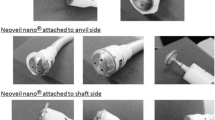Abstract
The healing of anastomoses performed by single- or double-row circular stapling instruments is analyzed in the dog colon. Mucosal healing is better in single-row stapled anastomoses. Apposition of the outer intestinal layers is superior in double-row stapled anastomoses. Bursting pressure and circular wall tension values are identical in both anastomotic types except at 24 hours after surgery when the strength of a double-row stapled anastomosis is superior. A cost-benefit analysis is still in favor of single-row circular instruments. In our opinion, adequate preoperative bowel preparation and a thorough surgical technique, when preparing the cut edges to be anastomosed and placing purse-string sutures, are infinitely more important than making a choice between single- or double-row stapling machines.
Similar content being viewed by others
References
Irwin TT. Wound healing: principles and practice. London: Chapman and Hall, 1981.
Hamilton JE. Reappraisal of open intestinal anastomoses. Ann Surg 1967;165:917–24.
Loeb MJ. Comparative strength of inverted, everted, and end-on intestinal anastomoses. Surg Gynecol Obstet 1967;125:301–4.
Trueblood HW, Nelsen TS, Kohatsu S, Oberhelman HA Jr. Wound healing in the colon: comparison of inverted and everted closures. Surgery 1969;65:919–30.
Yale CE, Van Gemert JV. Healing of inverted and everted intestinal anastomoses in germfree rats. Surgery 1971;69:382–8.
Goligher JC, Morris C, McAdam WA, de Dombal FT. A controlled trial of inverting versus everting intestinal suture in clinical large bowel surgery. Br J Surg 1970;57:817–22.
Irvin TT, Goligher JC, Johnston D. A randomised prospective clinical trial of single layer and two layer inverting intestinal anastomoses. Br J Surg 1973;60:457–60.
Everett WG. A comparison of one-layer and two-layer techniques for colorectal anastomosis. Br J Surg 1975;62:135–40.
Goligher JC, Lee PW, Simpkins KC, Lintott DJ. A controlled comparison of one- and two-layer techniques of suture for high and low colorectal anastomoses. Br J Surg 1977;64:609–14.
Fain SN, Patin CS, Morgenstern L. Use of a mechanical suturing apparatus in low colorectal anastomosis. Arch Surg 1975;110: 1079–82.
Goligher JC, Lee PW, Macfie MB, Simpkins KC, Lintott DJ. Experience with the Russian Model 249 suture gun for anastomosis of the rectum. Surg Gynecol Obstet 1979;148:517–24.
Bolton RA, Britton DC. Restorative surgery of the rectum with a circumferential stapler. Lancet 1980;1:850–1.
Ravitch MM, Steichen FM. A stapling instrument for end-to-end inverting anastomoses in the gastrointestinal tract. Ann Surg 1979;189:791–7.
Shahinian TK, Bowen JR, Dorman BA, Soderberg CH, Thompson WR. Experience with the EEA stapling device. Am J Surg 1980;139:549–53.
Beart RW, Kelly KA. Randomized prospective evaluation of the EEA stapler for colorectal anastomoses. Am J Surg 1981;141: 143–7.
Athanasiadis S, Barry BA, Girona J. Vergleich der behandlungsergebnisse bei dickdarmanastomosen mit den klammerhtgeräten EEA und SPTU in einem kollektiv von 260 patienten. Langenbecks Arch Chir 1981;354:111–6.
Athanasiadis S, Lufti T, Stahlnecker E, Barry BA, Girona J. Erfahrungen mit dem sovjetischen klammerahtgeräten SPTU in der kolon- und rektumchirurgie. Zbl Chirurgie 1982;107:711–7.
Negula T, Mandache E. Ultrastructural features of the healing area after everting and inverting suture of the small intestine in rabbits. Acta Morphol Acad Sci Hung 1974;22:227–39.
Nelsen TS, Anders CJ. Dynamic aspects of small intestinal rupture with special consideration of anastomotic strength. Arch Surg 1966;93:309–14.
Jansen A, Becker AE, Brummelkamp WH, Keeman JN, Klopper PI. The importance of the apposition of the submucosal intestinal layers for primary wound healing of intestinal anastomosis. Surg Gynecol Obstet 1981;152:51–8.
Lord MG, Valies P, Broughton AC. A morphologic study of submucosa of large intestine. Surg Gynecol Obstet 1977;145: 55–60.
Orberg JW, Klein L, Hiltner A. Scanning electron microscopy of collagen fibers in intestine. Connect Tissue Res 1982;9:187–93.
Stein E, Barry BA. Morphological examination of the healing of colonic anastomoses in the rat. Coloproctology 1983;5:140–4.
Williams CB, Lane RH, Sahai Y, Hanwell AE. Colonoscopy: an air-pressure hazard. Lancet 1973;2:729.
Kalinina TW. Die experimentelle Begründung der operation am mastdarm mit anwendung des apparats CK-28. In: Grizman JJ, ed. Chirurgische vernähungsapparate und ihre klinische anwendung. Moskau: v/o Medexport, 1976;6:98–9.
Author information
Authors and Affiliations
About this article
Cite this article
Penninckx, F.M., Kerremans, R.P. & Geboes, K.J. The healing of single- and double-row stapled circular anastomoses. Dis Colon Rectum 27, 714–719 (1984). https://doi.org/10.1007/BF02554594
Received:
Issue Date:
DOI: https://doi.org/10.1007/BF02554594




